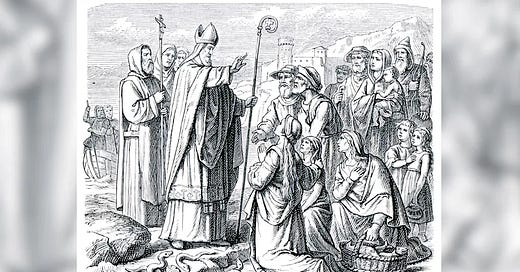Photo Credit: Britannica
Issue #280 Friday Funday March 17, 2023
Please make sure to view and act on the important information at the end of this article to help support “We Are Speaking.” Thank you!
Here are a few fun facts about St. Patrick and St. Patrick's Day Parades:
Saint Patrick is the patron saint of Ireland, known for bringing Christianity to the country. Contrary to popular belief, St. Patrick wasn't actually Irish himself—he was born in Britain!
St. Patrick's Day is celebrated on March 17, the anniversary of his death in 461 AD.
It's believed that the original color associated with St. Patrick was blue, not green! When Henry VIII claimed to be king of Ireland in the 16th century, his flag was blue, meaning that Ireland was also associated with the color. However, green was later used as the color of the flag in the Great Irish Rebellion of 1641, and the color green became a national symbol of pride for Ireland.
St. Patrick wasn't canonized as a saint until hundreds of years after his death.
Legend has it that St. Patrick drove all the snakes out of Ireland, but in reality, there were never any snakes to begin with—the island is too cold for them to survive!
St. Patrick's Day did not become a public holiday in Ireland until 1904.
Corned beef and cabbage is not a popular dish in Ireland.
The first recorded parade was held in New York City in 1762 when Irish soldiers serving with the British army marched through the city to commemorate the anniversary of Ireland's patron saint.
Leprechauns were not originally associated with St. Patrick's Day until 1959 when Disney released Darby O'Gill and the Little People about an old Irish man and his leprechaun friends. They weren't originally described as wearing green, but red instead!
From then on, parades became a regular public display of Irish-American pride.
Over time, they evolved and expanded to more elaborate affairs featuring bagpipers, marching bands, floats, concerts, and other forms of entertainment.
Do you celebrate St. Patrick’s Day? Do you know that it is still a religious holiday in Ireland?
Let us know in the comments.
You can always leave any questions in the comments or email us.
This article is free to access for 3 days after publication. Please consider becoming a paid subscriber for $5/month or less to access all of the articles and other benefits.
What else do Keith and Pam do?
Where else can you find us?
Click the link below to find out everything you need to know and review everything we offer for independent writers and creative and solo professionals.





